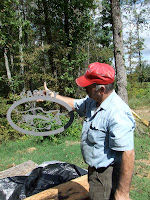There
is something that I have always wondered… can one woman, by herself, make a
difference? This question reminded
me of the following story:
One day a man was walking along the beach when he noticed a boy picking something up and gently throwing it into the ocean. Approaching the boy, he asked, "What are you doing?"
The youth replied, "Throwing starfish back into the ocean. The surf is up and the tide is going out. If I don't throw them back, they'll die."
"Son," the man said, "don't you realize there are miles and miles of beach and hundreds of starfish? You can't make a difference!"
After listening politely, the boy bent down, picked up another starfish, and threw it back into the surf. Then, smiling at the man, he said..."I made a difference for that one."
 |
| Cynthia Steele |
Although it is abundantly clear that this story is an example of how each of us can make a difference, it is also true that maybe we can make a difference by keeping the starfish off the beach in the first place. This is exactly what my friend, Cynthia Steele, attempts to do every day in Claiborne Parish. She spends her time, and an incredible amount of energy creating programs in the arts, volunteering, and finding ways to stimulate the population of Claiborne Parish. In her own way, Cynthia is involved in throwing the starfish back into the ocean, encouraging others to join in, and trying to keep them off the beach in the first place.
As
director of the Claiborne Jubilee, Cynthia attempts to keep the history and
culture of Claiborne Parish from dying, by hosting an annual CHAIRity auction
in which artists and locals design a chair that reflects a personal story,
which is a small piece of Claiborne Parish history. Although this event has only been in existence for 2 years,
the public has embraced it, and it has grown significantly. She took this process one step further,
by incorporating these artists into a dramatic group, called the Claiborne
Jubilee Players that presented their stories to the community in a series of
mini-plays. The combination of art, history and drama has created an opportunity
for the members of this small community to use their own personal stories to
start a conversation within the community that crosses all divides.
During
our conversation, Cynthia excitedly described and upcoming projects, a
cemetery walk, which offers an interactive way to learn about the
community’s history. This event, which takes place at the Old Homer Cemetery, will be hosted by the Claiborne
Jubilee Players, wearing period costumes, enacting the personas of the people
who are buried there by presenting first-person narratives of their lives and
experiences in Claiborne Parish.
This event will create communication between the past
and present that will increase awareness of the history and traditions of
this small community.
Cynthia
has also had a vital role in increasing the presence of visual arts within
Claiborne Parish as can be seen in the recent completion of the Kinnebrew Mural
Project, located on the square in Homer, Louisiana. After receiving a grant from the state’s Decentralized Art
Funds, Cynthia set this project in motion, by engaging Louisiana Tech Assistant
Professor, Nick Bustamante, to supervise the project and local artist, Judy
Buckner, to create the original image for the mural. Bustamante’s Louisiana Tech art student assisted him in the
transfer and painting of the mural, which took about 6 weeks. The completed mural is a compilation of
images from throughout the parish’s past, including images of the community’s
agricultural heritage, such as cattle, cotton, peaches, and timber, as well as
the community’s most famous visiting professor, Dr. George Washington
Carver. This mural is a constant
reminder of the history and culture that permeates our community, and an
example of how the arts can be used to create a conversation about these
topics. She has already started
planning the next mural.
I do believe after touching
on just a few of the endeavors that have been instigated by this inspiring
woman, that, yes… one woman can indeed make a difference. I’m just glad she lives in my
community!















